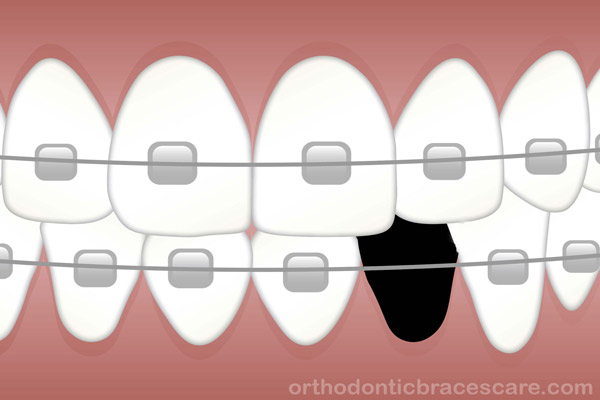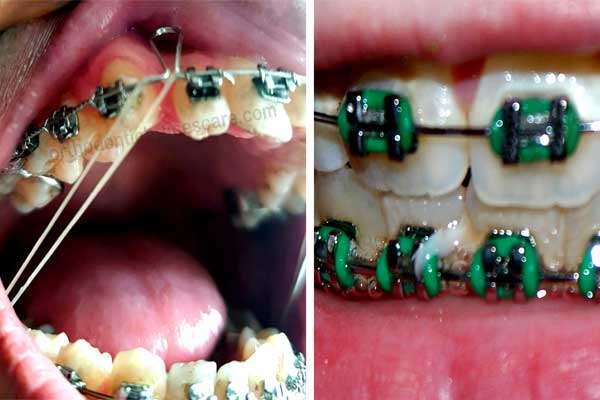Getting your braces removed is an exciting milestone, and most people expect their teeth to stay perfectly aligned forever. But is it possible to experience flared teeth after braces?
Flared teeth can occur after braces, especially if you don’t wear your retainers consistently or if the braces were removed before the treatment was fully completed. Fortunately, this issue can often be resolved by wearing retainers. For more severe cases, additional orthodontic treatments like braces or Invisalign might be necessary.
In this article, we’ll explore the causes of teeth flaring after braces and delve into effective solutions to address the problem.
What are flared teeth after braces?
Flared teeth after braces occur when your front teeth stick out more than expected after treatment. Instead of aligning with the rest of your smile, they tilt forward, creating a protruded look.
After months or years of braces, you might look in the mirror and think, “Why do my teeth still look off?”
This happens for a few reasons. Sometimes, during treatment, braces push teeth too far forward due to crowding or overexpansion of the dental arch. Other times, the retainer isn’t worn properly, allowing teeth to shift and flare outward.
A weak lip seal or tongue thrusting (when your tongue pushes against your front teeth) can gradually cause this issue over time. Flared teeth don’t just affect your appearance—they can impact your bite, speech, and jaw comfort. The good news?
It’s fixable. Solutions range from retainers and Invisalign to minor orthodontic adjustments. Addressing the cause early is key to keeping your smile straight!
It can be one of many causes of your teeth looking weird after braces.
Are flared teeth normal after braces?
A little shifting after braces is completely normal—your teeth have been held in place for months (or years), and now they’re settling into their new position. That’s why retainers are crucial!
If you don’t wear your retainer, your teeth can and will move back. Sometimes, this means flaring outward, especially if you had an overbite before braces.
Why are your teeth flared after braces?
Take a look at the causes of why your teeth flare after braces.
1. Tooth settling (Natural Shifting After Braces)
Teeth are living structures, constantly making tiny movements even after braces come off. This natural settling process can sometimes cause a bit of outward flaring, especially in patients who had significant crowding before treatment.
Usually, this stabilizes on its own, but in some cases, mild adjustments (like an aligner touch-up) might be needed to get things back in line.
2. Skipping the Retainer (The #1 Mistake)
Ah, the classic mistake. If I had a dollar for every patient who thought they could “just wear their retainer every now and then” and still maintain perfect results, I’d be retired on a beach somewhere.
Retainers are not optional—they’re the only thing standing between your straight smile and your teeth deciding to do their own thing.
When retainers aren’t worn consistently, teeth shift, gaps reopen, and flaring (increased overbite) can occur.
3. Removing braces before the treatment is completed
Look, I get it—patients want their braces off as soon as possible. But if teeth haven’t fully stabilized within the bone, they’re much more likely to flare once the brackets come off.
It’s like pulling out a stake before the cement sets—the foundation isn’t strong enough to keep things in place.
4. Poor-fitting retainer
Retainers are only as good as their fit. If yours feels loose or isn’t snug against your teeth, it’s not doing its job. I’ve had patients come back months later with flared teeth, only to find out their retainer wasn’t fitting properly from the start.
Always check with your orthodontist if something feels off—it’s way easier to fix early on than to wait until your teeth shift significantly.
5. Excessive Proclination During Treatment
Sometimes, the way your braces were set up can lead to flaring after treatment. If your orthodontist pushed your front teeth too far forward, they might stay that way or even flare more once the braces come off.
That’s why careful planning is so important—every smile is unique, and the wrong approach can create problems down the road.
6. Weak Lip & Cheek Muscles
Did you know your lips and cheeks actually play a big role in keeping your teeth in line? Yep, they work like natural retainers, holding everything in place.
If your oral muscles are on the weaker side, your teeth might start to flare out since there’s not enough resistance to keep them steady. The good news?
Simple exercises, like gently pressing your lips together, can help strengthen those muscles over time!
7. Incorrect Tooth Positioning
Sometimes, the way teeth were positioned during treatment can make them more likely to flare outward once braces are removed.
If the roots weren’t angled properly, or if the teeth weren’t brought back into alignment correctly, post-braces flaring can be an issue.
8. Bad oral habits
Old habits die hard, and unfortunately, some of them can wreck your smile. Thumb sucking, nail-biting, chewing on pens, or even using your teeth as tools (please don’t!) can put constant pressure on the front teeth, causing them to flare.
If you’ve been guilty of these habits, now’s the time to stop—your teeth will thank you.
9. Issue with your tongue
I see this a lot in younger patients, but adults aren’t immune. If you push your tongue against your front teeth when swallowing (aka tongue thrusting), you’re slowly moving them outward over time.
A larger-than-average tongue can also contribute to flaring by constantly pressing against the teeth. If this is happening, myofunctional therapy (tongue exercises) might be needed to correct it.
10. Not consulting with your orthodontist
If you don’t consult with your orthodontist, they may not be able to detect the early signs of flared teeth. This can further lead to extensive damage and may require surgery to fix the problem.
11. Poor Orthodontic Treatment Outcome
Not all orthodontic treatments are created equal. If the original treatment wasn’t executed correctly—whether due to improper bracket placement, an inaccurate bite assessment, or lack of attention to detail—flaring can be an unfortunate side effect. This is why choosing an experienced orthodontist matters!
12. Inappropriate treatment planning
Flared teeth can sometimes happen when the treatment plan for braces isn’t quite right. In many cases, creating enough space by removing certain teeth is key to getting them properly aligned.
If there’s not enough room in your mouth and teeth aren’t removed when needed, flared teeth might still be an issue even after braces.
Sometimes, it’s not just about space—big or small jawbones can also play a role in flared teeth. In those cases, surgery might be needed to fix the underlying issue. Without it, getting everything perfectly aligned can be tough.
A good orthodontist will create a treatment plan that’s personalized for you. But occasionally, patients choose to skip extractions or surgery, which can lead to flared teeth after treatment is done.
The key to the best results is working closely with your orthodontist and making a plan that works for you!
13. Orthodontic Relapse (Teeth Trying to Move Back)
If your original bite was severely misaligned, your teeth will naturally want to shift back—this is called orthodontic relapse. Even years after braces, you can experience flaring if your bite wasn’t fully corrected.
How to fix flared teeth after braces?
Here are some ways to fix teeth flaring after braces.
1. Wear Your Retainer (Or Get a New One!).
Let’s start with the easiest fix. Are you wearing your retainer as prescribed? If not, that’s likely why your teeth are shifting. Retainers don’t just maintain results—they can also correct minor flaring if caught early. But if your retainer doesn’t fit snugly, it may need an adjustment or replacement.
With a Hawley retainer (removable wire type), your orthodontist might tweak it to apply pressure and shift your teeth back.
If you have a clear plastic retainer (like Essix or Vivera) that doesn’t fit, you might need a new one or a short round of aligners.
Pro tip: If your retainer feels tight when you put it in, that’s a sign your teeth are already shifting. Keep wearing it consistently to help stop further movement!
2. Get clear aligners (Invisalign).
If your teeth have flared too much for a retainer, clear aligners could be the solution. They gradually move teeth back into alignment without needing full braces. Unlike retainers, aligners apply pressure to reposition teeth. Minor cases can be fixed in as little as 3-6 months, though severe cases may take longer.
When to consider aligners:
- Your flaring is noticeable and affecting your bite.
- Your retainer no longer fits properly.
- You have mild to moderate flaring but don’t want braces again.
3. Interproximal Reduction (IPR – Slimming Down Teeth for Better Fit)
Flared teeth can happen when there’s not enough space in the dental arch, causing them to push forward.
One solution is Interproximal Reduction (IPR), where tiny amounts of enamel (0.2–0.5mm per tooth) are removed to create room for the teeth to move back.
It’s painless and won’t weaken your enamel. IPR is often paired with clear aligners to guide teeth into position.
4. Orthodontic Re-Treatment (Braces Again? Maybe.)
If your flaring is severe, and your teeth weren’t fully corrected the first time, you might need a second round of orthodontic treatment. Don’t worry—sometimes a short 3-9 month treatment with partial braces or aligners can fix the problem.
Your orthodontist might use power chains (elastic links) or TADs (mini-implants) to move teeth more efficiently.
Good news: If it’s just your front teeth flaring, you might only need braces on your top or bottom teeth, not your whole mouth!
5. Permanent Fixed Retainer (To Keep Things Stable!)
If you’ve already fixed flared teeth, the last thing you want is for them to shift again. A permanent fixed retainer (a thin wire bonded behind your front teeth) prevents movement and works 24/7 without needing to remember it.
Struggling to stick with removable retainers? This might just be what you need!
6. Jaw Expansion (For Cases Where the Arch is Too Narrow)
Sometimes teeth flare out due to a lack of space in the arch. If that’s the case, your orthodontist may suggest palatal expansion for younger patients or surgically assisted expansion for adults to create a wider, more stable bite.
While not common, it’s worth noting if space was a problem during your original treatment.
7. Correcting Tongue Thrust or Oral Habits
If your flaring is caused by tongue thrusting, nail-biting, or other habits, fixing the teeth alone won’t stop relapse. You need to address the root cause.
Myofunctional therapy (tongue exercises) can retrain swallowing and tongue position, reducing pressure on your teeth.
Signs you may need Myofunctional therapy:
- You rest your tongue against your front teeth when swallowing.
- You breathe through your mouth instead of your nose.
- You notice pressure from your tongue pushing on your teeth.
8. Veneers or Bonding (For Aesthetic Fixes Only)
If your flared teeth aren’t severely misaligned but just look slightly off, cosmetic treatments like bonding or veneers could work.
These don’t fix the root cause but can reshape your teeth to look straighter. This is best if your bite is stable with no risk of future shifting.
Best for:
- Very mild flaring that doesn’t affect function.
- Patients who want an instant cosmetic fix.
- Those who don’t want orthodontic treatment again.
How to Prevent Flared Teeth After Braces?
You went through months (or years!) of braces to get that perfect smile—now, the last thing you want is for your teeth to start flaring out again. The good news? Prevention is easier than correction.
If you take the right steps now, you can keep your smile straight and avoid another round of orthodontic treatment. Here’s how to stop flared teeth before they start.
1. Consistent Retainer Use – Your #1 Defense
I can’t stress this enough—if you don’t wear your retainer, your teeth will shift. Retainers are not optional, no matter how perfect your teeth looked the day your braces came off.
There are three types of retainers, and each plays a different role:
- Hawley Retainer (Removable with a Wire) – Allows for minor adjustments, durable, but more noticeable.
- Essix Retainer (Clear Plastic) – Nearly invisible, but can wear out faster and may need replacement every few years.
- Permanent (Bonded) Retainer – A thin wire glued behind your teeth for 24/7 protection—great for people who forget to wear removable retainers.
Pro Tip: If your retainer starts feeling tight, your teeth are shifting! Wear it more often, and don’t wait until it stops fitting entirely.
2. Monitoring Tooth Movement – Catch Problems Early
Your teeth are always moving—it’s just how biology works. Some small shifts are normal, but if you start noticing flaring, act fast. Here’s how to check:
- Look at your teeth in the mirror once a month. If the front teeth look wider apart or stick out more, they might be flaring.
- Try putting in your old retainer. If it feels tight, your teeth have already started shifting.
- Check your bite alignment. If your teeth don’t fit together like they used to, subtle movement could be happening.
If you catch changes early, a simple retainer adjustment can often fix them without needing full orthodontic treatment again.
3. Maintaining Proper Oral Habits
You might not realize it, but bad habits can mess up your teeth alignment. Even tiny, repeated pressures (like biting your nails or pressing your tongue against your teeth) can cause flaring over time.
Avoid these habits to keep your teeth in place:
- Tongue Thrusting – Pushing your tongue against your teeth when swallowing can force them outward.
- Lip Biting or Chewing on Pens – Constant pressure on your front teeth leads to gradual shifting.
- Mouth Breathing & Bad Posture – Believe it or not, how you breathe and hold your head affects your bite. If your tongue doesn’t rest properly on the roof of your mouth, your teeth can move forward.
If you struggle with tongue thrusting or bad oral posture, myofunctional therapy can help retrain these habits.
4. Regular Orthodontic Check-Ups – Don’t Skip These!
I know, I know—you probably thought you were done with orthodontic visits after getting your braces off. But those follow-up checkups are crucial. Even if your teeth look fine, your orthodontist can catch tiny shifts before they turn into major problems.
How often should you go? Every 6-12 months in the first couple of years post-braces, then as needed after that.
What to expect? Your orthodontist will check your retainer fit, tooth positioning, and any signs of flaring.
Why is it important? Small issues can be fixed fast and cheaply—but if you wait too long, you might need braces again.
How long does it take to fix flared teeth after braces are removed?
The time needed to fix flared teeth after braces depends on the severity of the issue and the treatment method.
For mild flaring, consistently wearing a properly fitted retainer can correct the problem in a few weeks to a few months.
Moderate flaring may require clear aligners like Invisalign, which typically take 3-6 months to realign teeth.
Severe flaring, often caused by improper treatment or lack of retention, may need a short phase of braces or aligners, lasting 6-12 months.
In rare cases, additional work like Interproximal Reduction (IPR) or palatal expansion might be required, extending treatment time.
Early intervention is crucial—the sooner you address the issue, the easier it is to fix. If you notice flaring, don’t wait—schedule a visit with your orthodontist to find the best solution for your smile!
In short: This depends on the severity of your case:
Mild flaring → A few months with a retainer or Invisalign
Moderate flaring → 6-12 months with Invisalign or minor braces treatment
Severe flaring → Up to 1-2 years if full braces or surgery is required
Do retainers help with flared teeth after braces?
Retainers are an effective solution for correcting flared teeth. By maintaining the teeth in their proper alignment after braces are removed, they help prevent any shifting back to their original position.
If you’re considering using retainers to address flared teeth, it’s essential to consult your orthodontist. They can evaluate your specific situation and recommend the most suitable treatment plan for you.
Conclusion
Flared teeth after braces aren’t uncommon, but they’re 100% fixable. The key is wearing your retainer, avoiding bad habits, and following up with your orthodontist if you notice any shifting.
If your teeth are flaring out and you’re worried about it, don’t wait—the sooner you act, the easier it is to fix!

Dr. Pallab Kishore, MS in Orthodontics and owner of Orthodontic Braces Care, shares expert tips on braces, aligners, and oral health from 10+ years of experience.


